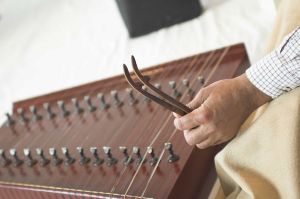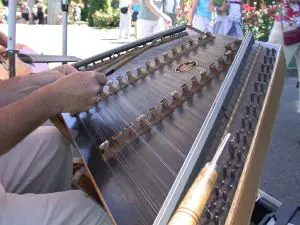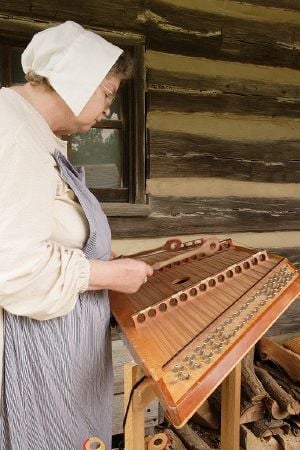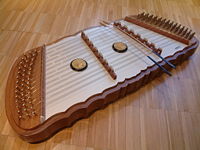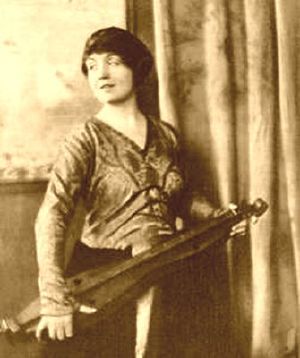Difference between revisions of "Dulcimer" - New World Encyclopedia
Dave Eaton (talk | contribs) |
|||
| Line 68: | Line 68: | ||
===Origins=== | ===Origins=== | ||
| − | Although the Appalachian dulcimer appeared in regions dominated by Irish and Scottish settlement, the instrument has no known precedent in Ireland or Scotland. However, several diatonic fretted zithers exist in Continental Europe, which bear a strong similarity to the dulcimer. [[Jean Ritchie]] (''The Dulcimer Book'', 1974) and others have speculated that the Appalachian dulcimer is related to similar European instruments like the [[langeleik]], [[scheitholt]], and [[epinette des Vosges]]. | + | Although the Appalachian dulcimer appeared in regions dominated by Irish and Scottish settlement, the instrument has no known precedent in [[Ireland]] or [[Scotland]]. However, several diatonic fretted zithers exist in Continental [[Europe]], which bear a strong similarity to the dulcimer. [[Jean Ritchie]] (''The Dulcimer Book'', 1974) and others have speculated that the Appalachian dulcimer is related to similar European instruments like the [[langeleik]], [[scheitholt]], and [[epinette des Vosges]]. |
===Playing=== | ===Playing=== | ||
| − | A traditional way to play the instrument is to lay it flat on the lap and pluck or strum the strings with one hand, while fretting with the other. The dulcimer may also be placed in a similar position on a piece of furniture such as a table or chest of drawers, to enhance the sound. There are two predominant methods of fretting. First, the strings may be depressed with the fingertips of the fretting hand. Using this technique, all the strings may be fretted allowing the player to produce | + | A traditional way to play the instrument is to lay it flat on the lap and pluck or strum the strings with one hand, while fretting with the other. The dulcimer may also be placed in a similar position on a piece of furniture such as a table or chest of drawers, to enhance the sound. There are two predominant methods of fretting. First, the strings may be depressed with the fingertips of the fretting hand. Using this technique, all the strings may be fretted allowing the player to produce [[chord]]s. Second, the melody string, the string closest to the player, may be depressed with a noter, typically a short length of dowel or bamboo (see photo at left). Using this method, only the [[melody]] string is fretted and the other strings act as [[drone (music)|drone]] strings (the melody string may be doubled so that the melody can be better heard over the drones). In this second style of playing, the combination of the drone strings and the buzz of the noter on the [[melody]] strings produces a unique sound. |
| − | In practice, a wide variety of playing styles have long been used. Jean Ritchie's ''The Dulcimer Book'' (1974) has an old photograph of Mrs. Leah Smith of Big Laurel, Kentucky, playing the dulcimer with a bow instead of a pick, with the tail of the dulcimer held in the player's lap, and the headstock resting on a table pointing away from her. In their book ''In Search of the Wild dulcimer'' (1974), Robert Force and Al d'Ossché describe their preferred method as "guitar style": the dulcimer hangs from a strap around the neck, and the instrument is fretted and strummed like a guitar; they also describe playing "Autoharp style" where "the dulcimer is held vertically with the headstock over the shoulder." Lynn McSpadden, in his book ''Four and Twenty Songs for the Mountain Dulcimer'', states that some players "tilt the dulcimer up sideways on their laps and strum in a guitar style." Still other dulcimer players use a fingerstyle technique, fingering chord positions with the fretting hand and rhythmically plucking individual strings with the strumming hand, creating delicate arpeggios. | + | In practice, a wide variety of playing styles have long been used. Jean Ritchie's ''The Dulcimer Book'' (1974) has an old photograph of Mrs. Leah Smith of Big Laurel, Kentucky, playing the dulcimer with a bow instead of a pick, with the tail of the dulcimer held in the player's lap, and the headstock resting on a table pointing away from her. In their book ''In Search of the Wild dulcimer'' (1974), Robert Force and Al d'Ossché describe their preferred method as "guitar style": the dulcimer hangs from a strap around the neck, and the instrument is fretted and strummed like a [[guitar]]; they also describe playing "Autoharp style" where "the dulcimer is held vertically with the headstock over the shoulder." Lynn McSpadden, in his book ''Four and Twenty Songs for the Mountain Dulcimer'', states that some players "tilt the dulcimer up sideways on their laps and strum in a guitar style." Still other dulcimer players use a fingerstyle technique, fingering [[chord]] positions with the fretting hand and rhythmically plucking individual strings with the strumming hand, creating delicate arpeggios. |
| − | Contemporary players have also borrowed from chord theory and guitar analogues to create a variety of more complex ways to play the dulcimer. Some dulcimers are constructed with four equidistant strings to facilitate playing more complex chords, particularly for playing jazz. In another line of contemporary innovation, electric dulcimers have been used in rock music. The Appalachian dulcimer is both easy to learn to play, and capable of complexity, providing scope for a wide range of professionals and hobbyists. | + | Contemporary players have also borrowed from [[chord]] theory and guitar analogues to create a variety of more complex ways to play the dulcimer. Some dulcimers are constructed with four equidistant strings to facilitate playing more complex chords, particularly for playing [[jazz]]. In another line of contemporary innovation, electric dulcimers have been used in rock [[music]]. The Appalachian dulcimer is both easy to learn to play, and capable of complexity, providing scope for a wide range of professionals and hobbyists. |
===Strings and tuning=== | ===Strings and tuning=== | ||
| − | The [[fret]]s of the Appalachian dulcimer are typically arranged in a [[diatonic scale]]. Traditionally, the Appalachian dulcimer was usually tuned to DAA, or notes with this 1 5 5 relationship. The key note is on the bass string and the middle string is an interval of a perfect fifth above it. The melody string is tuned so that the key note is at the third fret. This facilitates playing melodies in the [[Ionian mode]]. The melody played on the top string (or string pair) only, with the unfretted drone strings providing a simple harmony, gives the instrument its distinctive traditional sound. To play in a different key, or in a different mode, a traditional player would have to retune the instrument. For example, to play a minor mode melody the instrument might be tuned to DAC. This facilitates playing the [[Aeolian mode]], where the scale begins at the first fret. | + | The [[fret]]s of the Appalachian dulcimer are typically arranged in a [[diatonic scale]]. Traditionally, the Appalachian dulcimer was usually tuned to DAA, or notes with this 1-5-5 relationship. The key note is on the bass string and the middle string is an interval of a perfect fifth above it. The [[melody]] string is tuned so that the key note is at the third fret. This facilitates playing melodies in the [[Ionian mode]]. The [[melody]] played on the top string (or string pair) only, with the unfretted drone strings providing a simple [[harmony]], gives the instrument its distinctive traditional sound. To play in a different key, or in a different mode, a traditional player would have to retune the instrument. For example, to play a minor mode melody the instrument might be tuned to DAC. This facilitates playing the [[Aeolian mode]], where the scale begins at the first fret. |
[[Image:Dulcimer1917vogue.jpg|thumb|A photo from the May 1, 1917 issue of [[Vogue (magazine)|Vogue]], featuring an Appalachian dulcimer.]] | [[Image:Dulcimer1917vogue.jpg|thumb|A photo from the May 1, 1917 issue of [[Vogue (magazine)|Vogue]], featuring an Appalachian dulcimer.]] | ||
| − | Modern instruments usually include an additional fret a half step below the octave position, the so-called "six and a half" fret. This enables one to play in the Ionian mode when tuned to DAD, the traditional tuning for the [[Mixolydian mode]], where the scale starts on the open fret. This arrangement is often found to be more conducive to chordal playing, as opposed to the more traditional dronal style. Among modern players, it is fair to say that the instrument is most commonly tuned to DAD. So-called "chromatic dulcimers" are sometimes made, to permit play in any key without re-tuning. | + | Modern instruments usually include an additional fret a half step below the [[octave]] position, the so-called "six and a half" fret. This enables one to play in the Ionian mode when tuned to DAD, the traditional tuning for the [[Mixolydian mode]], where the scale starts on the open fret. This arrangement is often found to be more conducive to chordal playing, as opposed to the more traditional dronal style. Among modern players, it is fair to say that the instrument is most commonly tuned to DAD. So-called "chromatic dulcimers" are sometimes made, to permit play in any key without re-tuning. |
| − | While currently the most common tuning is DAD, it is often easier for the beginning player to tune to DAA or the so-called "Reverse Ionian" tuning, (DGD). "Reverse" tunings are ones where the key note is on the middle string and the bass string is the fifth of the scale, but in the octave below the middle string. This is sometimes suggested as an easier tuning. From (DGD) one can put a [[capo]] on the first fret to play the [[Dorian mode]], or retune the second string to (A), to play the [[Mixolydian mode]], then from Mixolydian capo the first fret to play the [[Aeolian mode]]. DAA tuning should not be thought of as simply a "beginner" tuning, however. Many accomplished, innovative players use this tuning. | + | While currently the most common tuning is DAD, it is often easier for the beginning player to tune to DAA or the so-called "Reverse Ionian" tuning, (DGD). "Reverse" tunings are ones where the key note is on the middle string and the bass string is the fifth of the [[scale]], but in the [[octave]] below the middle string. This is sometimes suggested as an easier tuning. From (DGD) one can put a [[capo]] on the first fret to play the [[Dorian mode]], or retune the second string to (A), to play the [[Mixolydian mode]], then from Mixolydian capo the first fret to play the [[Aeolian mode]]. DAA tuning should not be thought of as simply a "beginner" tuning, however. Many accomplished, innovative players use this tuning. |
===Usage=== | ===Usage=== | ||
The Appalachian dulcimer is widely used in the American [[old-time music]] tradition. The instrument first appeared in the early 1800s from the [[Scotch-Irish American|Scots-Irish]] in the southern [[Appalachian Mountains]], and is thus also called a '''mountain dulcimer'''. The instrument became used as a parlor instrument, as its sound volume was well-suited to small home gatherings. | The Appalachian dulcimer is widely used in the American [[old-time music]] tradition. The instrument first appeared in the early 1800s from the [[Scotch-Irish American|Scots-Irish]] in the southern [[Appalachian Mountains]], and is thus also called a '''mountain dulcimer'''. The instrument became used as a parlor instrument, as its sound volume was well-suited to small home gatherings. | ||
| − | The Appalachian dulcimer achieved a renaissance in the 1950s urban [[folk music]] revival in the United States through the work of [[Jean Ritchie]], a [[Kentucky]] musician who introduced the instrument to [[New York City]] audiences. In the 1960s, the American folk musician [[Richard Fariña]] (1937–1966) became the first to utilize an Appalachian dulcimer in a less traditional way, pointing out its similarity in tone to some [[Middle East]]ern and [[Asia]]n instruments. Styles performed by modern dulcimer enthusiasts run the gamut from traditional folk music through popular and experimental forms, although most perform in more or less traditional styles. The increasing popularity of solid-body electric mountain dulcimers can be evidenced through performers such as [http://www.lindsaybuckland.com/ Lindsay Buckland] [[Bing Futch]], [http://www.ButchRoss.com/ Butch Ross] and [http://www.QuintinStephens.com/ Quintin Stephens]. Dulcimer festivals take place regularly in the United States, Canada, the United Kingdom, and Ireland, as the Appalachian dulcimer has achieved a following in a number of countries. | + | The Appalachian dulcimer achieved a renaissance in the 1950s urban [[folk music]] revival in the [[United States]] through the work of [[Jean Ritchie]], a [[Kentucky]] musician who introduced the instrument to [[New York City]] audiences. In the 1960s, the American folk musician [[Richard Fariña]] (1937–1966) became the first to utilize an Appalachian dulcimer in a less traditional way, pointing out its similarity in tone to some [[Middle East]]ern and [[Asia]]n instruments. Styles performed by modern dulcimer enthusiasts run the gamut from traditional [[folk music]] through popular and experimental forms, although most perform in more or less traditional styles. The increasing popularity of solid-body electric mountain dulcimers can be evidenced through performers such as [http://www.lindsaybuckland.com/ Lindsay Buckland] [[Bing Futch]], [http://www.ButchRoss.com/ Butch Ross] and [http://www.QuintinStephens.com/ Quintin Stephens]. Dulcimer festivals take place regularly in the [[United States]], [[Canada]], the [[United Kingdom]], and [[Ireland]], as the Appalachian dulcimer has achieved a following in a number of countries. |
===Variants=== | ===Variants=== | ||
Revision as of 23:51, 15 November 2008
The dulcimer stringed musical instrument of two main varieties. In the case of the hammered dulcimer, the strings stretched over a trapezoidal sounding board. Typically, the hammered dulcimer is set on a stand at an angle in front of the musician, who holds small mallet hammers in each hand to strike the strings. The Appalachian dulcimer, also called a mountain dulcimer, is a narrower instrument of the zither family with three to five strings and a fretted fingerboard, played by strumming with a small stick, quill, or plectrum with the right hand, while and the left hand controls the melody or chords.
The word dulcimer is Graeco-Roman, meaning "sweet song," derived from the Latin dulcis (sweet) and the Greek melos (song). The dulcimer's origin is uncertain, but tradition holds it was invented in Iran some 2000 years ago, where it is called a Santur (cf. the folkloric Kashmiri Santoor). There are wood carvings that depict stringed instruments played with wooden beaters dating as far back as 1500 B.C.E.
The instrument has been revived in the U.S. in the American folk music traditions. Some rock bands employ the hammered dulcimer as a primary instrument, including Macha of Athens, Ga., and Tulsa Drone of Richmond, Va. The dulcimer is played in Wales, East Anglia, Northumbria, Southwest Asia, China, and Thailand, and in traditional Austrian and Bavarian folk music.
Hammered dulcimer
The early version of the dulcimer (also known as the santur) was known in cultures from Greece to Mongolia and was known in India and throughout the Middle East and was widely used in rural areas due to its portability and relative ease of use. It was often used to accompany weddings and dances. European trade to the West and the Orient was an important factor in its use in the new world. It became an instrument that was associated with folk music and buskers. One reason for it's eventual decline was that is was not easy to build good quality instruments that could stay in tune. The instrument never achieved the popularity that the harpsichord or piano did and as such European composers of the seventeenth, eighteenth and nineteenth centuries did not write music for it.
Strings and tuning
The hammered dulcimer comes in various sizes, identified by the number of strings that cross each of the bridges. A 15/14, for example, has two bridges (treble and bass) and spans three octaves. The strings of a hammered dulcimer are usually found in pairs, two strings for each note (though some instruments have three or four strings per note). Each set of strings is tuned in unison and is called a course. As with a piano, the purpose of using multiple strings per course is to make the instrument louder, although as the courses are rarely in perfect unison, a chorus effect usually results. A hammered dulcimer, like an autoharp or harp, requires a tuning wrench for tuning. Unlike the strings of a guitar, the dulcimer's strings are wound around simple bolts (called tuning pins) with square heads.
The strings of the hammered dulcimer are often tuned diatonically, according to a circle of fifths pattern. Typically, the lowest note (often a G or D) is found on the lower right-hand corner of the instrument, just to the left of the right-hand (bass) bridge. As a player strikes the courses above in sequence, they ascend the diatonic scale based on the G or D. With this tuning, the scale is broken into two tetrachords, or groups of four notes. For example, on an instrument with D as the lowest note, the D major scale is played starting in the lower-right corner and ascending the bass bridge: D - E - F# - G. This is the lower tetrachord of the D major scale. At this point the player returns to the bottom of the instrument and shifts to the treble bridge to play the higher tetrachord: A - B - C# - D.
This shift to the adjacent bridge is required because the bass bridge's fourth string G is the start of the lower tetrachord of the G scale. If the player ascends the first eight strings of the bass bridge, they will encounter a flatted seventh (C natural in this case), because this note is drawn from the G tetrachord. This D major scale with a flatted seventh is the mixolydian mode in D.
The pattern continues to the top of the instrument and to the left-hand side of the treble bridge. Moving from the left side of the bass bridge to the right side of the treble bridge is analogous to moving from the right side of the treble bridge to the left side of the treble bridge.
This diatonically-based tuning results in most, but not all, notes of the chromatic scale being available in each key. To fill in the gaps, many modern dulcimer builders include extra short bridges at the top and bottom of the soundboard, where extra strings are tuned to some or all of the missing pitches. Such instruments are often called "chromatic dulcimers" as opposed to the more traditional "diatonic dulcimers."
Hammered dulcimers of non-European descent may have other tuning patterns, and builders of European-style dulcimers sometimes experiment with alternate tuning patterns.
Hammers
The hammered dulcimer derives its name from the small mallets that players use to strike the strings, called hammers. They are usually made of wood, but can be made from any material, including metal and plastic. In the Western hemisphere, hammers are usually stiff, but in Asia, flexible hammers are often used. The head of the hammer can be left bare for a sharp attack sound, or can be covered with adhesive tape, leather, or fabric for a softer sound.
Several traditional players have used hammers that differ substantially from those in common use today. Paul Van Arsdale (b. 1920), a player from upstate New York, uses flexible hammers made from hacksaw blades, with leather-covered wooden blocks attached to the ends (these are modeled after the hammers used by his grandfather, Jesse Martin). The Irish player John Rea (1915-1983) used hammers made of thick steel wire, wound with wool. He made these himself from old bicycle spokes. Billy Bennington (1900-1986), a player from Norfolk county in England, used cane hammers bound with wool.
The hammered dulcimer (as well as the mountain dulcimer), can also be bowed, though this is not a widespread practice, as a traditional bow would do little good. In order to make bowing the instrument possible, bowhammers, and more recently Jimbows, were created. Bowhammers are a unique invention used by musician Michael Masley. Jimbows consist of a wooden handle connected to a curved nylon rod, which when rosined, will produce the desired sound.
Four hammer dulcimer
The four hammer dulcimer, although a fresh innovation premiering in the early 1990's, is by no means a new instrument. The hammered dulcimer, not to be confused with the mountain dulcimer, has been around for millennia. The four hammer dulcimer is the same instrument played with special hammers and technique.
The first record of a four hammer dulcimer is Glenn McClure's variation of the Burton grip. McClure's hammers are wooden dowels with teardrop-shaped heads. One hammer is held between the pad of the thumb and the midsection of the forefinger. The handle of the second hammer is a 2.5cm square pad, which is gripped in the middle and ring fingers.
Another hammer design is two standard flat-handled hammers riveted together about 4cm from the base so they can pivot. As of yet, no technique has been developed for these hammers.
The most recent innovation in four hammer dulcimer playing is the clip-on hammer, designed by Hasso Pape (HAH-soh PAH-pee) in 2006. The clip on hammer is a wooden dowel with an elliptical spheroid head, similar to the McClure hammers. One hammer is strapped to the farthest section of each of the index and middle fingers by a 1.5cm strip of elastic adjustable by Velcro. Strings are struck in a finger motion similar to that of piano playing.[citation needed]
Hammered dulcimers around the world
Versions of the hammered dulcimer are used throughout the world. In Eastern Europe a larger descendant of the hammered dulcimer called the cimbalom is played and has been used by a number of classical composers, including Zoltán Kodály, Igor Stravinsky and Pierre Boulez, and more recently, in a different musical context, by Blue Man Group. The khim is a Thai hammered dulcimer. The Chinese yangqin is a type of hammered dulcimer that originated in Persia. The Santur and Santoor are found in the Middle East and India, respectively.
The cimbalom, which is similar to the hammer dulcimer, has been used by many composers in the twentieth century. Hungarian composer (and colleague of Bela Bartok) Zoltán Kodáky featured the cimbalom extensively in his orchestral suite Háry János which helped popularize the instrument outside Europe. Bartok scored for cimbalom in his Rhapsody #1 for Violin and Orchestra. Russian composer Igor Stravinsky owned a cimbalom and included the instrument in two of his compositions Renard and Les Noces. Contemporary composers who utilized the cimbalom in their works include Pierre Boulez, Peter Eötvös, György Kurtág, Frank Zappa, Louis Andriessen Henri Dutilleux, Elvis Costello and Harrison Birtwhistle.
Appalachian dulcimer
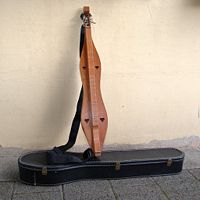
| ||||||
|
The Appalachian dulcimer is a fretted string instrument of the zither family, typically with three or four strings. The body extends the length of the fingerboard, and its fretting is generally diatonic.
Origins
Although the Appalachian dulcimer appeared in regions dominated by Irish and Scottish settlement, the instrument has no known precedent in Ireland or Scotland. However, several diatonic fretted zithers exist in Continental Europe, which bear a strong similarity to the dulcimer. Jean Ritchie (The Dulcimer Book, 1974) and others have speculated that the Appalachian dulcimer is related to similar European instruments like the langeleik, scheitholt, and epinette des Vosges.
Playing
A traditional way to play the instrument is to lay it flat on the lap and pluck or strum the strings with one hand, while fretting with the other. The dulcimer may also be placed in a similar position on a piece of furniture such as a table or chest of drawers, to enhance the sound. There are two predominant methods of fretting. First, the strings may be depressed with the fingertips of the fretting hand. Using this technique, all the strings may be fretted allowing the player to produce chords. Second, the melody string, the string closest to the player, may be depressed with a noter, typically a short length of dowel or bamboo (see photo at left). Using this method, only the melody string is fretted and the other strings act as drone strings (the melody string may be doubled so that the melody can be better heard over the drones). In this second style of playing, the combination of the drone strings and the buzz of the noter on the melody strings produces a unique sound.
In practice, a wide variety of playing styles have long been used. Jean Ritchie's The Dulcimer Book (1974) has an old photograph of Mrs. Leah Smith of Big Laurel, Kentucky, playing the dulcimer with a bow instead of a pick, with the tail of the dulcimer held in the player's lap, and the headstock resting on a table pointing away from her. In their book In Search of the Wild dulcimer (1974), Robert Force and Al d'Ossché describe their preferred method as "guitar style": the dulcimer hangs from a strap around the neck, and the instrument is fretted and strummed like a guitar; they also describe playing "Autoharp style" where "the dulcimer is held vertically with the headstock over the shoulder." Lynn McSpadden, in his book Four and Twenty Songs for the Mountain Dulcimer, states that some players "tilt the dulcimer up sideways on their laps and strum in a guitar style." Still other dulcimer players use a fingerstyle technique, fingering chord positions with the fretting hand and rhythmically plucking individual strings with the strumming hand, creating delicate arpeggios.
Contemporary players have also borrowed from chord theory and guitar analogues to create a variety of more complex ways to play the dulcimer. Some dulcimers are constructed with four equidistant strings to facilitate playing more complex chords, particularly for playing jazz. In another line of contemporary innovation, electric dulcimers have been used in rock music. The Appalachian dulcimer is both easy to learn to play, and capable of complexity, providing scope for a wide range of professionals and hobbyists.
Strings and tuning
The frets of the Appalachian dulcimer are typically arranged in a diatonic scale. Traditionally, the Appalachian dulcimer was usually tuned to DAA, or notes with this 1-5-5 relationship. The key note is on the bass string and the middle string is an interval of a perfect fifth above it. The melody string is tuned so that the key note is at the third fret. This facilitates playing melodies in the Ionian mode. The melody played on the top string (or string pair) only, with the unfretted drone strings providing a simple harmony, gives the instrument its distinctive traditional sound. To play in a different key, or in a different mode, a traditional player would have to retune the instrument. For example, to play a minor mode melody the instrument might be tuned to DAC. This facilitates playing the Aeolian mode, where the scale begins at the first fret.
Modern instruments usually include an additional fret a half step below the octave position, the so-called "six and a half" fret. This enables one to play in the Ionian mode when tuned to DAD, the traditional tuning for the Mixolydian mode, where the scale starts on the open fret. This arrangement is often found to be more conducive to chordal playing, as opposed to the more traditional dronal style. Among modern players, it is fair to say that the instrument is most commonly tuned to DAD. So-called "chromatic dulcimers" are sometimes made, to permit play in any key without re-tuning.
While currently the most common tuning is DAD, it is often easier for the beginning player to tune to DAA or the so-called "Reverse Ionian" tuning, (DGD). "Reverse" tunings are ones where the key note is on the middle string and the bass string is the fifth of the scale, but in the octave below the middle string. This is sometimes suggested as an easier tuning. From (DGD) one can put a capo on the first fret to play the Dorian mode, or retune the second string to (A), to play the Mixolydian mode, then from Mixolydian capo the first fret to play the Aeolian mode. DAA tuning should not be thought of as simply a "beginner" tuning, however. Many accomplished, innovative players use this tuning.
Usage
The Appalachian dulcimer is widely used in the American old-time music tradition. The instrument first appeared in the early 1800s from the Scots-Irish in the southern Appalachian Mountains, and is thus also called a mountain dulcimer. The instrument became used as a parlor instrument, as its sound volume was well-suited to small home gatherings.
The Appalachian dulcimer achieved a renaissance in the 1950s urban folk music revival in the United States through the work of Jean Ritchie, a Kentucky musician who introduced the instrument to New York City audiences. In the 1960s, the American folk musician Richard Fariña (1937–1966) became the first to utilize an Appalachian dulcimer in a less traditional way, pointing out its similarity in tone to some Middle Eastern and Asian instruments. Styles performed by modern dulcimer enthusiasts run the gamut from traditional folk music through popular and experimental forms, although most perform in more or less traditional styles. The increasing popularity of solid-body electric mountain dulcimers can be evidenced through performers such as Lindsay Buckland Bing Futch, Butch Ross and Quintin Stephens. Dulcimer festivals take place regularly in the United States, Canada, the United Kingdom, and Ireland, as the Appalachian dulcimer has achieved a following in a number of countries.
Variants
As a folk instrument, wide variation exists in Appalachian dulcimers.
- Number of Strings: Dulcimers may have as few as two or as many as 12 strings (in six courses). Instruments with fewer than two strings would more properly be termed monochords.
- Body Shape: Dulcimers appear in a wide variety of body types, many of which are recorded in "A Catalog of Pre-Revival Dulcimers." A representative array would include: hourglass, teardrop, trapezoid, rectangular, elliptical ("Galax-style"), violin-shaped, fish-shaped, and lute-back.
- "Courting Dulcimer": One unusual variant is the "courting dulcimer." This instrument consists of one large dulcimer body with two separate fingerboards. The instrument is laid across the laps of two facing individuals (the eponymous "courting" pair) and used to play duets.
- "Bowed Dulcimer": Dulcimers can be modified to be played with bows, with extensive modifications.
Experimental dulcimer variants
- Banjo dulcimer: also called a Banjo-mer resembles a standard dulcimer, but with a banjo-head on the body. Invented by Doug Thomson a well known dulcimer player in the bluegrass community.
- Resonator dulcimer: a standard dulcimer, with a resonator added to the body, in imitation of the resonator guitar. This variant was first explored by Homer Ledford [citation needed] and called the "dulcibro."
- Aquavina: a dulcimer employing a metal resonator filled partially with water. The resonator is agitated while playing, producing an eerie oscillation of the harmonic
ReferencesISBN links support NWE through referral fees
- Gifford, Paul M. (2001), The Hammered Dulcimer: A History, The Scarecrow Press, Inc. ISBN 0-8108-3943-1. A comprehensive history of the hammered dulcimer and its variants.
- Kettlewell, David (1976), The Dulcimer, PhD thesis. History and playing traditions around the world; web-version at http://www.new-renaissance.net/dulcimer.
External links
- Santur on Nay-Nava, the encyclopedia of Persian music instruments
- Hammered Dulcimer Information
- Hammered Dulcimer Sample Library & MP3 Demos
- Klezmer Tsimbl (Related to the Hammered Dulcimer)
- Smithsonian Institution booklet on hammered dulcimer history and playing
- Smithsonian Institution booklet on making a hammered dulcimer (by Sam Rizzetta)
- In Search of the Wild Dulcimer - online version of the book on the author's site.
- Dulcimer Players News, a magazine in publication since 1974, for hammered and fretted "dulcimer" enthusiasts.
- Everything Dulcimer - Highly popular community on the web featuring articles, listings and discussion forums.
- Everything Dulcimer - Highly popular community on the web featuring articles, listings and discussion forums.
Credits
New World Encyclopedia writers and editors rewrote and completed the Wikipedia article in accordance with New World Encyclopedia standards. This article abides by terms of the Creative Commons CC-by-sa 3.0 License (CC-by-sa), which may be used and disseminated with proper attribution. Credit is due under the terms of this license that can reference both the New World Encyclopedia contributors and the selfless volunteer contributors of the Wikimedia Foundation. To cite this article click here for a list of acceptable citing formats.The history of earlier contributions by wikipedians is accessible to researchers here:
The history of this article since it was imported to New World Encyclopedia:
Note: Some restrictions may apply to use of individual images which are separately licensed.
